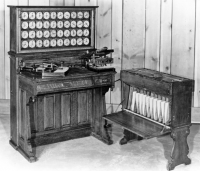








A punched card, punch card, IBM card, or Hollerith card is a piece of stiff paper that contained either commands for controlling automated machinery or data for data processing applications. Both commands and data were represented by the presence or absence of holes in predefined positions.
Now obsolete as a recording medium, punched cards were widely used throughout the 20th century for controlling textile looms and in the late 19th and early 20th century for controlling fairground organs and related instruments. Punched cards were used through most of the 20th century in what became known as the data processing industry; the use of unit record machines, organized into data processing systems, for data input, processing, and storage.Early digital computers used punched cards, often prepared using keypunch machines, as the primary medium for input of both computer programs and data.
As of 2012, some voting machines still utilize punched cards to record data.
History
Punched cards were first used around 1725 by Basile Bouchon and Jean-Baptiste Falcon (fr) as a more robust form of the perforated paper rolls then in use for controlling textile looms in France. This technique was greatly improved by Joseph Marie Jacquard in his Jacquard loom in 1801.
Semen Korsakov was reputedly the first to use the punched cards in informatics for information store and search. Korsakov announced his new method and machines in September 1832; rather than seeking patents, he offered the machines for public use.
Charles Babbage proposed the use of "Number Cards", "pierced with certain holes and stand opposite levers connected with a set of figure wheels ... advanced they push in those levers opposite to which there are no holes on the card and thus transfer that number" in his description of the Calculating Engine's Store.
Herman Hollerith invented the recording of data on a medium that could then be read by a machine. Prior uses of machine readable media, such as those above (other than Korsakov), had been for control, not data. "After some initial trials with paper tape, he settled on punched cards...", developing punched card data processing technology for the 1890 US census.
Hollerith founded the Tabulating Machine Company (1896) which was one of four companies that merged to form Computing Tabulating Recording Company (CTR), later renamed the International Business Machines Corporation (IBM). IBM manufactured and marketed a variety of unit record machines for creating, sorting, and tabulating punched cards, even after expanding into electronic computers in the late 1950s. IBM developed punched card technology into a powerful tool for business data-processing and produced an extensive line of general purpose unit record machines. By 1950, the IBM card and IBM unit record machines had become ubiquitous in industry and government. "Do not fold, spindle or mutilate," a generalized version of the warning that appeared on some punched cards (generally on those distributed as paper documents to be later returned for further machine processing, checks for example), became a motto for the post-World War II era.
From the 1900s, into the 1950s, punched cards were the primary medium for data entry, data storage, and processing in institutional computing. According to the IBM Archives: "By 1937... IBM had 32 presses at work in Endicott, N.Y., printing, cutting and stacking five to 10 million punched cards every day."Punched cards were even used as legal documents, such as U.S. Government checks and savings bonds. The UNITYPER introduced magnetic tape for data entry in the 1950s. During the 1960s, the punched card was gradually replaced as the primary means for data storage by magnetic tape, as better, more capable computers became available. Mohawk Data Sciences introduced a magnetic tape encoder in 1965, a system marketed as a keypunch replacement which was somewhat successful, but punched cards were still commonly used for data entry and programming until the mid-1980s when the combination of lower cost magnetic disk storage, and affordable interactive terminals on less expensive minicomputers made punched cards obsolete for this role as well.However, their influence lives on through many standard conventions and file formats. The terminals that replaced the punched cards, the IBM 3270 for example, displayed 80 columns of text in text mode, for compatibility with existing software. Some programs still operate on the convention of 80 text columns, although fewer and fewer do as newer systems employ graphical user interfaces with variable-width type fonts.
Today punched cards are mostly obsolete and replaced with other storage methods, except for a few legacy systems and specialized applications.